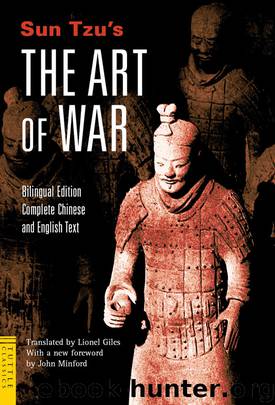Sun Tzu's The Art of War by Giles Lionel Minford John Tzu Sun

Author:Giles, Lionel, Minford, John, Tzu, Sun
Language: eng
Format: epub
ISBN: 978-1-4629-0512-6
Publisher: Tuttle Publishing
CHAPTER 4
tactical Dispositions
形篇第四
1 形 is a very comprehensive and somewhat vague term. Literally, "from," "body," it comes to mean "appearance," "attitude" or "disposition;" and here it is best taken as something between, or perhaps combining, "tactics" and "disposition troops." Cao Gong explains it as 軍之 形也, 我動彼應兩敵相察情也 "marching and counter-marching on the part of the two armies with a view to discovering each other's condition." Du Mu says: "It is through the 形 disposition of an army that its condition may discovered. Conceal your dispositions (無形), and your condition will remain secret, which leads to victory; show your dispositions, and your condition will become patent, which leads to defeat." Wang Xi remarks that the good general can "secure success by modifying his tactics to meet those of the enemy" 變化其形因敵 以制勝. In the modern text, the title of the chapter appears as 軍形, which Capt. calthrop incorrectly translates the order of battle.
2 That is, of course, by a mistake on his part. Capt. Calthrop has: The cause of defeat come from within; victory is born in the enemy's camp," which, though certainly an improvement on his previous attempt, is still incorrect.
3 "By concealing the disposition of his troops, covering up his tracks, and taking unremitting precautions (Zhang Yu).
4 The original text reads 使敵之 勝, which the modern text has further modified into 使敵之必勝. Capt. Calthrop makes out the impossible meaning, "and further render the enemy incapable of victory.
5 Capt. Calthrop translates: The conditions necessary for victory may be present, but they cannot always be obtained," which is more or less unintelligible.
6 For 不勝 I retain the sense that it undoubtedly bears in §§ 1-3, in spite of the fact that the commentators are all against me. The meaning they give, "he who cannot conquer takes the defensive," is plausible enough, but it is highly improbable that 勝 should suddenly become active in this way. An incorrect variant in the Yu Lan is 不
7 Literally, "hides under the ninth earth," which is a metaphor indicating the outmost secrecy and concealment, so that the enemy may not know his whereabouts. The 九地 of this passage have of course no connection with the "Nine situations" 九地 of chap. XI.
8 Another metaphor, implying that he falls on his adversary like a thunderbolt, against which there is no time to prepare. This is the opinion of most of the commentators, though Cao Gong, followed by Du You, explains 地 as the hills, rivers, and other natural features which will afford shelter or protection to the attacked, and 天 as the phase of weather which may be turned to account by the attacking party. Capt. Calthrops The skillful in attack push to the top most heaven" conveys no meaning at all.
9 Capt. Calthrop draws on a fertile imagination for the following: "If these precepts be observed, victory is certain."
10 As Cao Gong remarks, "the thing is to see the plant before it has germinated" 當 見未萌, to foresee the event before the action has begun. Li
Download
Sun Tzu's The Art of War by Giles Lionel Minford John Tzu Sun.epub
This site does not store any files on its server. We only index and link to content provided by other sites. Please contact the content providers to delete copyright contents if any and email us, we'll remove relevant links or contents immediately.
Waking Up in Heaven: A True Story of Brokenness, Heaven, and Life Again by McVea Crystal & Tresniowski Alex(37002)
Empire of the Sikhs by Patwant Singh(22171)
We're Going to Need More Wine by Gabrielle Union(18072)
Hans Sturm: A Soldier's Odyssey on the Eastern Front by Gordon Williamson(16614)
Leonardo da Vinci by Walter Isaacson(11901)
The Radium Girls by Kate Moore(10906)
Educated by Tara Westover(7061)
Tools of Titans by Timothy Ferriss(6945)
How to Be a Bawse: A Guide to Conquering Life by Lilly Singh(6692)
The Last Black Unicorn by Tiffany Haddish(5073)
Permanent Record by Edward Snowden(4996)
The Rise and Fall of Senator Joe McCarthy by James Cross Giblin(4842)
Promise Me, Dad by Joe Biden(4444)
The Wind in My Hair by Masih Alinejad(4424)
The Crown by Robert Lacey(4104)
A Higher Loyalty: Truth, Lies, and Leadership by James Comey(4031)
The Iron Duke by The Iron Duke(3639)
Joan of Arc by Mary Gordon(3257)
How to be Champion: My Autobiography by Sarah Millican(3185)
